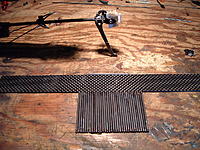-
 Views: 690
Views: 690
Yellow arrow = clear scotch tape for balancing Blue arrow = -002 70 duro oring Red arrow = Bearing retainer that spins -
 Views: 555
Views: 555
Xtreme tail box with original bearings removed. -
 Views: 548
Views: 548
New tail using Xtreme tail box. Boca bearings are C/Aed into place "mandatory step" -
 Views: 506
Views: 506
I also made new tail blades from 1/32" carbon fiber and tail fin from 1/16" carbon fiber. -
 Views: 496
Views: 496
Blue arrow = New Boca 440C sealed high speed bearing C/Aed into position very carefully slide out bearings and use very small drop of C/A behind bearing. -
 Views: 525
Views: 525
Let C/A set up using card board to secure bearings firmly while they set up.
Comments (0)
Add Comment
-
 Views: 278
Views: 278
#50 hole being drilled into Heliworx head. -
 Views: 238
Views: 238
Head being tapped for 2/56 stainless set screws. -
 Views: 265
Views: 265
Set screws installed and being spun up to speed to check for straightness. It's straight as can be ready to be sent home. -
 Views: 326
Views: 326
Heliworx head next to one of my own heads. Not much difference between the two as you can see.
-
 Views: 257
Views: 257
I recieved all this from Boca bearings free of charge for writing this bearing information in my blog. There is a hat,stickers,cool mouse pad and heli bearing kit price brochure. -
 Views: 289
Views: 289
Using blue locktite on the lower radial bearing. The lower mounting hole was a little on the loose side. The upper radial bearing mounting hole was a very snug fit. -
 Views: 313
Views: 313
Thrust bearing installed without outside disk. -
 Views: 348
Views: 348
Thrust bearing installed, radial bearing is below it.
-
 Views: 298
Views: 298
Drilling head with #50 drill for 1/16" long, cone tip 2/56 set screws which fit precisely into the pin hole of the mainshaft. -
 Views: 227
Views: 227
Head ready to be tapped for 2/56 threaded set screws. -
 Views: 253
Views: 253
Set screws installed on both sides of head. This head is now removable with out having to take the mainshaft out of the heli. No more pins to mess with. -
 Views: 234
Views: 234
Using 5/64's A2 tool steel rod for main shaft. The new rod is under the original, I'm using the original mainshaft as a template to prevent the drill from wandering and to make sure the holes are in exactly the correct position. -
 Views: 211
Views: 211
Setting this all straight before drilling, the new precision shaft is stacked under the original one. -
 Views: 226
Views: 226
New mainshaft "left" next to original, after drilling before heat treatment. -
 Views: 214
Views: 214
New tight tolerance mainshaft after heat treating. This mainshaft is .0006" larger diameter than original which means it fits into the swash and bearings with absolutely zero play. Less play = less vibrations. -
 Views: 206
Views: 206
Beveling the .039" hole using a drill bit. Each hole has to be done this way one at a time.
Sticky:
Chevell's Xtreme frame mods
-
 Views: 232
Views: 232
New mounting position for the ESC. Making room for 850mah lipo. -
 Views: 311
Views: 311
Landing gear struts to add strength and stiffness to the landing gear. Notice the carbon struts with the black heat shrink holding them in position. This mod is still being tested but so far it's taken a few hard landings with no problems. -
 Views: 269
Views: 269
This is my custom canopy mount, I didn't like the thin stock carbon mount. I used thicker carbon rod from drive shaft for this plus shrink tubing to hold in place. -
 Views: 196
Views: 196
Xtreme tail with Boca bearings and carbon fiber fin and tail blades. -
 Views: 243
Views: 243
The .015" carbon plate shim is under the set screw for the boom. The displaces the load from the screw to prevent cracking. You can also tighten this screw much tighter. -
 Views: 191
Views: 191
To reduce linkage play I'm using -002 orings which work really well. I'm using one for each link end and three at the upper swash. -
 Views: 225
Views: 225
Rear strut mount with carbon shim and set screw added to increase strength. This also keeps the struts from falling out. -
 Views: 241
Views: 241
Xtreme landing gear with carbon cross braces held in place with shrink tubing. Struts now have solid mounting point and landing gear is much stronger than before.
